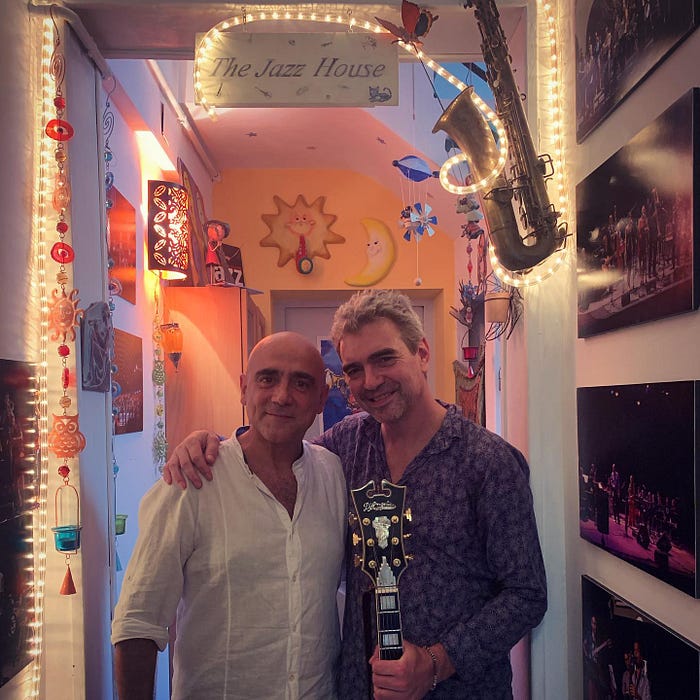Josep Traver: Guitarist of all Trades

Jazz fans who are fortunate enough to know the Sant Andreu Jazz Band and the remarkable music the project has produced in the past fifteen years — by young musicians ranging from roughly 8 years old to 21 — also know the work of guitarist Josep Traver, who has been and continues to be an integral part of the band’s history and music. Appearing on countless recordings and in concerts and club gigs with the SAJB and its smaller side groups, his role as teacher and sideman with the band has been invaluable — and plain to see in the hundreds of the band’s videos on YouTube.
Traver, 53, became interested in the guitar while still a toddler. “I started a long time ago,” he says with a laugh. “When I was 3 years old, I wanted an electric guitar. I told my sister I wanted a ‘hippie guitar.’ I didn’t know that it was an electric guitar, but I saw on TV bands with the long hair and electric guitars. I was amazed by the sound of the guitar, and when I’d see people in the street with a guitar case, I’d say ‘wow’ — I like the shape, the sound, it’s like magic for me. I started at the music school when I was 7 years old. And when I was 12 or 13, we’d start to play together — Beatles songs, pop music — then when I was 18, I started to study at the Escola Musica de Badalona, and there they introduced me to jazz, jazz standards…I also play country, I love bluegrass music, I love gypsy music. It’s an open-minded school…Nowadays I’m teaching there, ‘cause when I was 24 I finished my studies, but they asked me to be a teacher there. I was lucky!”
His early, casual acquaintance with a Barcelona musician and music teacher named Joan Chamorro was somehow destined to take on a far greater significance over time. Chamorro had created the Sant Andreu Jazz Band in 2006, striving to instill an appreciation of classic jazz in his students of the Escola Municipal de Musica de Sant Andreu. When not teaching, he was playing gigs.

“We met playing in a Dixieland band,” Traver recalls. “Sometimes the band would play on the streets. We first met on a gig, and after that we met more often, and one day — this was maybe 16 years ago — he had a gig and asked me to join him and make a band. The connection [between us] was so good, we started to work together.”
Among the original members of Chamorro’s SAJB was 11-year-old Andrea Motis. As the small band began to take shape, Chamorro nutured the young musicians as they learned mostly Dixieland jazz. As the number of members grew, the repertoire expanded into genres such as swing, Brazilian bossa nova, and traditional music of the region. Andrea in particular began to stand out as an exceptional trumpeter, saxophone player, and singer — in a word, a natural.

As Traver recalls, “I think Andrea was maybe 14 when [Chamorro] saw her potential, and started bringing her to his gigs. I remember me, Andrea, a clarinet player, a trombone player — we went to play in Mallorca three days for a jazz festival. She was a little girl, and came with her father Ramon, and later they decided to make the recording, and put the band together.”
What did he think when he first heard Andrea?
“For me, it was a surprise, because you’re accustomed to playing with professional people, not with kids. At first, it was not the normal thing. She had a very child-like voice, but she was singing well, and I was pretty amazed by the way she played saxophone. Joan is a sax teacher, and I remember when we played ‘The Sunny Side of the Street,” by Johnny Hodges, and she played the whole solo by memory. It’s almost 3 minutes of music, and I was, ‘wow,’ she’s a talented girl. And when she sings, she never has the lyrics in front of her, she has it all in her memory. And with the years, she kept growing, and now she has a more mature voice, with more sophisticated things as a trumpet player. She’s a super-talented woman.”
Traver then met the brilliant pianist Ignasi Terraza and drummer Esteve Pi in the studio, to play for the 2010 album Joan Chamorro presenta Andrea Motis.

It was the first album to feature an individual SAJB musician, with the 14-year-old Andrea quickly gaining the reputation as a true jazz prodigy. “Joan put together all the pieces of the quintet,” Traver says. “My guitar with Ignassi’s piano, Esteve on drums and with Andrea — and more people, like Eva Fernandez” [Eva, another original SAJB member and saxophonist extraordinaire, had just turned 16 at the time].

In addition to keeping busy on other musical projects with various European and American professionals, Traver, Terraza, and Pi found themselves becoming regular sidemen for an array of recordings and live gigs featuring the SAJB musicians, in various combinations — and, with Chamorro, became the quintet for a new phase of almost perpetual concerts and recordings, with Andrea as lead, and touring around the world, spanning Europe from corner to corner, and to distant lands such as Israel and Japan.
“Joan is a super cool guy, and he’s been trusting me for many projects. When he needs a guitar player, he calls and says, ‘Josep come and play.’ For me, it’s a way to grow, because he gave me the opportunity to play with a bunch of amazing musicians, like Scott Hamilton, John Allred, and good musicians from Spain too, like Perico Sambeat. Joan’s happy with my kind of approach to the music, because I’m not a jazz musician strictly, but I am an eclectic musician, I can play a little pop, a little finger picking, a little blues, bossa nova, and it fits so well in his projects.”
Traver was also instrumental (no pun intended) in bringing another young musical sensation to the SAJB, Rita Payes.
“I think Rita was 12 years old when she came to the Badalona music school. Her parents were teachers in a primary school of music in a small town, and they have a connection with our music school. Sometimes when students are ending their studies at the smaller school, they come to Badalona. And her parents told us Rita, and Ruth Marguenda, were coming to our school. I was teaching a little ensemble, and they came to play with us. And I was amazed with Rita, and Ruth, because they were capable of reading any chart of music, and they had a very good pitch and intonation, and I asked Rita if she wanted to sing, and she said okay.”
“One time, I remember Joan asked me — he was looking for a trombone player [for the SAJB], and asked if I knew a trombone player, and I told him, ‘Yes, I have a very talented little girl in my ensemble at the school, and I think she will fit so well with the band.’
So I presented Rita to Joan, and they started to play. And Rita was… wow!”

Rita was such an immediate sensation that Chamorro quickly added her to the group of female SAJB singers — Andrea, Eva, and bassist Magali Datzira — who were recording the first La Magia de la Veu (The Magic of the Voice) album of standards originally sung by American legends Ella Fitzgerald, Billie Holiday, Dinah Washington, and Sarah Vaughn. Two further albums featuring Rita — consisting of both live and studio tracks — were recorded and released in short order: Joan Chamorro presenta Rita Payes and Lua Amarela. “That’s because she’s so talented,” Traver says. “And she came from a musical family — her parents are musicians, and her brother is a trumpet player also. She got a musicality background from the family, and with the SAJB, it was like, wow” [he gestures a plane taking off].
But Traver is perhaps most proud of yet another SAJB member, and his longtime student, Andrea’s younger sister Carla, who joined the band in 2008, and left as a regular member in 2020.

“Carla was the one and only guitar player with the SAJB. She learned guitar at the school in Sant Andreu, then she came with me to the school at Badalona, maybe when she was 13, and I was her teacher for 8 years. And now she’s studying at Badalona University, for her degree in music. And for me it’s a joy because she’s playing nowadays, she’s growing and studying, and will be a teacher and musician, and it’s a joy for me to see that.”
A favorite among SAJB enthusiasts, Carla is known for her quiet demeanor, precise playing, and rather intense concentration. Traver explains that it’s simply an extension of her personality.
“Yeah, she’s a very quiet girl, she’s super cool, I think she plays in a quiet manner. I have a very good relationship with Carla — I’d help her with more difficult music of the SAJB sometimes, or when Joan and I were trying to improvise. She was a little shy at the beginning, she didn’t want to improvise, and Joan was telling her, ‘Carla, improvise!’ and she would say ‘No.’ ”
With time, the shyness gave way to growing confidence, “and these days she has a really nice sound and super good sense of timing of the rhythms, she’s a super solid rhythm player, and she’s doing a lot of interesting improvisations, too. I’m so proud of Carla. She’s a lovely girl, I can tell you.”

As of this writing, however, there is no future SAJB guitarist in sight — not that Carla could be easily replaced anyway. “I have some students,” Traver ponders, “but they are not prepared yet. I think the guitar was a very special and important part of the band. You can play without guitar in a big band, but I think the sound fits so well with the saxophones or with the trumpets. It brings a beautiful color to it.”
He is especially fond of a duet he and Carla recorded for her album Joan Chamorro presenta Carla Motis. “I love the song ‘As Long as I Live’ that we played together. I love it because we’re playing together — you start when she’s the student and you’re the teacher, but then you are playing in the same bubble, it’s very inspiring.”
The comment invites comparison with how there was perhaps a similar moment when Joan Chamorro first saw Andrea as more of an equal, rather than as a student. “Of course,” he agrees. “Joan told me once, and I think it’s interesting — when you’re on the stage, you might think that you’re ‘smaller’ than another musician, but at the time you’re performing on stage, you’re in the same bubble, and you must have confidence and trust yourself, and play like an equal. And then the things are working. It’s an interesing thing with the SAJB because Joan put together different pieces, with young people, with more experienced professional musicians, and they fit together and learn from each other, it’s a super interesting thing.”
He continues his point of how much of an education a young musician can gain simply by playing with other, more experienced people, rather than in a conventional school-like setting.
“I think this is a kind of thing that happened in the past, in the big bands like Duke Ellington; they were professional musicians, but maybe Charlie Parker started to play in a big band when he was 16, or something like that. Many years ago, in the big bands, it was a mix of young people and, you know... sometimes you can learn in school, of course, sometimes you can learn on the stage. When you meet different people it’s a combination of energies, and of course people can learn more things saying nothing, only watching, with musicians, than reading a book…If you are on the stage watching and listening and playing with one of the most amazing musicians, its an amazing experience. Its another kind of learning, more like the old days.

“I’m sure that Louis Armstrong didn’t go to a school of music, or Duke Ellington, because this kind of learning happened the same with the gypsy musicians, like Django Reinhardt — who didn’t even write his name because he never went to school — but the gypsy kids are very talented musicians, because they learn by watching and listening to their elders. You don’t need any more…”
He strummed a few chords on his guitar, Django Reinhardt-style.
“ — Only watching, listening and learning.”
While Chamorro’s teaching methods and their results have gained the attention of music teachers and jazz band directors around the world, Traver sees the idea behind it as rather matter-of-fact.
“Listen, imitate, copy — you can analyze after. It’s like when you learn to talk, You say ‘mama’ and ‘papa’ and ‘chair’ and ‘I want water.’ But you don’t know if water is a verb or — you don’t know anything, or the grammar. You only say the phrase. It’s the same thing in music. You must learn, but not with much analyzing, and having a good reference, and then if you listen to the people that play…it’s a very good background for you. And after, you can do your own thing, of course, you must investigate and create new things. But at first it’s a super interesting way of learning — imitate, transcribing, and take all the things — dynamics, experiencing a lot of things.

“For me it’s not a new way of teaching. He’s keeping the tradition of teaching… one thing that makes Joan different, I think, is his passion for the music, his energy, amazing — he’s a good man, it’s his personality. Another is trusting in people. Then people get confidence. If you tell me I can do that, okay, I can do that. Joan would say, ‘okay, play me that song.’ ‘this is pretty difficult for me.’ ‘Try it. Try just a bit of that, and keep going.’ And people keep going because he’s trusting in people, and he can transmit this kind of confidence. I think that’s the main thing. He has a very special ability.”

But surely the students must have some talent to begin with as well. An argument might be made that if, for example, Andrea’s next-door neighbor of the same age took the same lessons, and practiced the same songs and arrangements as Andrea, the results might still fall far short of Andrea’s talents and accomplishments.
“Of course,” Traver says. “The musicians have different kinds of talents. Joan says he doesn’t have special, more talented people in the band — they are normal people. But when you work every week, and you have projects, and you work in an environment where all the people are so connected in the music, when you have to record a cd, and have concerts, it makes you grow. But they are normal people. Of course, they are talented people — Andrea, Rita, Magali, Eva, Elia, Alba, Joan Mar, Marc Martin — they are really nice musicians, but if you have talent but don’t work, your talent is nothing, because you can’t improve. There are many people with talent in the SAJB, but in this environment, they grow up and work, with a good background, and they can blossom. But it is not a condition to get into the band. That’s a good thing, because maybe one kid is good at solos, but another is not — not everybody could stand in the front line. Like me, I am a sideman, but I am comfortable with my job as a sideman, because a frontman has other things to do — singing, talking…the sideman is more quiet.”

His point brings to mind Elsa Armengou, younger sister of SAJB lead trumpeter Alba Armengou. Elsa is also a superb trumpet player in the band, who occasionally takes center stage to play lead on a song (usually a ballad) featuring one of her flawless solos, but who spends most of her time doing section work — and not singing. “Everyone has his or her own personality, and Joan respects that,” Traver explains. “He has a lot of sociability.”
The SAJB, like everyone else, struggled through the Covid pandemic with many canceled concerts and recording sessions in 2020 and part of 2021, until life began to return to near-normal, allowing the band to celebrate its fifteenth year with several musical events. As for these first days of 2022, the stubborn and distressing Covid presence once again threatens to wreak havoc.
“It’s a bad thing for the musicians and for the culture,” Traver says, “because there are a lot of projects that have stopped, and nowadays we need the music and to enjoy concerts, but we are in these hard times for the music, but I hope it’s the ending of the peak of the pandemic. A lot of our gigs and travels got canceled, and I hope this next year will be more ’quiet’ in a sense. I hope the next year will be more normal.”
Happily, among other projects, he begins 2022 recording again with former SAJB trumpeter Joan Mar Sauqué, and bassist Giuseppe Campisi, for Joan Mar’s second post-SAJB album.
While he hopes 2022 will be “quiet” for him, jazz fans — and especially SAJB followers — hope to see still more of Josep Traver’s exquisite musicianship, with his fellow veterans as well as the rising young players in one of the world’s most exciting and endearing musical projects.
Until next time…
You can read my previous articles about the SAJB at the links below, or at the “Garry’s Blog” page on my website: www.GarryBerman.com.
You can also become a member in the Medium Partner Program to help support my writing. https://garryberman.medium.com/membership
“How a Kids Band in Barcelona Rekindled My Love of Jazz” https://medium.com/@garryberman/how-a-kids-band-in-barcelona-rekindled-my-love-of-jazz-a20ea8873670
“Joan Chamorro and the SAJB: Past, Present, and Future” https://garryberman.medium.com/joan-chamorro-and-the-sajb-past-present-and-future-573eedcbff76
“When American Jazz Pros Meet Spanish Jazz Kids” https://garryberman.medium.com/when-american-jazz-pros-meet-spanish-jazz-kids-25c7f5023571
“Claudia Rostey: The Life of an 18-year-old Bacelona Jazz Trombonist” https://garryberman.medium.com/claudia-rostey-the-life-of-an-18-year-old-barcelona-jazz-trombonist-d13b82c770a3
“The Magic of the Voice: The Singers of the Sant Andreu Jazz Band” https://garryberman.medium.com/the-magic-of-the-voice-the-singers-of-the-sant-andreu-jazz-band-208dfb629221
“Jobim is Alive and Well in Barcelona” https://garryberman.medium.com/jobim-is-alive-and-well-in-barcelona-d384b40d8c2e
“Did Someone Say Anastasia Ivanova?” https://garryberman.medium.com/did-someone-say-anastasia-ivanova-dd6f67277c64
“Struck by (musical) Lightning” https://garryberman.medium.com/struck-by-musical-lightning-6583ecb0de13
Sant Andreu Jazz Band CDs are available at: https://jazztojazz.com/ , eBay, and Amazon.com.








